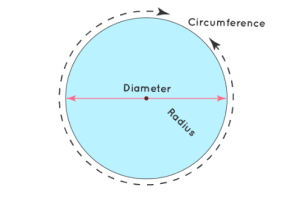Circumference is the distance around the outside of a circle and with our handy calculator, you will be able to find it in no time. All you have to do is mention the radius and you will be presented with the circumference and other information. Try it out!
RESULTS
Understanding Circumference and Circle Parameters
Discover the intricacies of a circle’s boundary with our examination of circumference and its critical relationship to other circular parameters.
Unlocking these concepts not only enhances your mathematical toolset but also connects you to universal principles applicable in countless real-world situations.
Definition Of Circumference
The circumference is the total distance around a circle. Think of it as the path you would walk if you went all the way around a round garden once. To find this length, you use a special number called pi (Π), which is about 3.14159.
The formula to get the circumference is simple: C = 2ΠR. This means you multiply pi by two times the radius of your circle – that’s how far it is around! If someone asks for the earth’s circumference or just a tiny ring, it’s found using this same rule.
Formula For Calculating Circumference
To find the distance around a circle, you use the circumference formula. It is simple: C = 2ΠR. In this equation, “C” stands for circumference, “Π” (pi) is about 3.14159, and “R” means radius.
The radius is a straight line from the center of the circle to any point on its edge.
You can quickly calculate using just one number – either the diameter or radius. If you know how long the middle of a circle is (that’s the diameter), just divide it by two to get your radius.
Then multiply by Π and 2 to get your answer for how big the circle is!
Relationship Between Diameter, Radius, and Circumference
A circle has a distance around it called the circumference. Think of it like the edge of a round pool. The diameter is a straight line that goes from one side to the other and passes through the center, like walking across the pool.
The radius is half of the diameter – just like half your step from one side to the middle.
Now, all these parts are linked together with math. If you know how big your pool is (the circumference), you can find out how wide it is (the diameter). You do this by dividing the circumference by Pi (about 3.14).
Also, if you want to figure out how far it is from one edge to the center (the radius), just take that width and cut it in half! It’s cool because once you have any one piece of information about a circle, you can work out everything else.
Usage and Benefits Of The Circumference Calculator
There are a lot of benefits to using our circumference calculator, let’s discuss!
1. Accurate And Precise Measurements
Getting your circle measurements right is key. The Circumference Calculator makes sure you have exact numbers for things like the distance around a circle, which is called circumference, and other important parts like diameter and radius.
You just put in one value, and it tells you all the rest! It can handle different units too—whether you’re thinking in inches or miles.
This tool uses a special math formula to get the circumference spot on. If you need to know how big a ball is inside or how much space it takes up on all sides, this calculator figures that out too with no mistakes.
Working with circles becomes super easy using this handy calculator!
2. User-Friendly Interface For Easy Calculation
The Circumference Calculator makes math easy. You can enter a number for the radius or diameter and it gives you the circumference fast. This tool is great for homework or solving problems without stress. It works on your computer, tablet, or phone so you can use it anywhere.
This calculator is not just smart but also simple to use. Pick the unit like inches or centimeters then type in your number. The calculator does all the hard work and shows each step so you learn too.
Next time you need to know about circle areas or perimeters, this calculator will help right away! Now let’s talk about how using this tool helps you get better at math.
FAQs
Question: How Do I Use pi In Calculations?
Pi is an irrational number you use to figure out the circle’s perimeter or area with formulas like “pi times radius squared” for the area and “pi times diameter” for the circumference.
Question: Can This Tool Tell Me The Length Of A Part Of The Circle’s Edge?
Yes, by using terms from geometry such as radii, chord, tangent, or secant lines, you can measure lengths on parts of a curve like minor arcs or even quarter-circles.
Question: Is There Proof That The Value Of Pi Never Ends?
Yes, mathematicians show that pi is transcendental; it means it keeps going without repeating after decimal places!
Question: Why Should We Learn About Diameters And Radii?
Learning these mathematical terms helps us understand circles better since they are important in everything from understanding Earth’s big size to making cookies round!
Question: Did Someone Really Measure How Big Around The Earth Is?
Yes! A Greek mathematician named Eratosthenes used sticks and shadows to estimate Earth’s huge curve over two thousand years ago!

